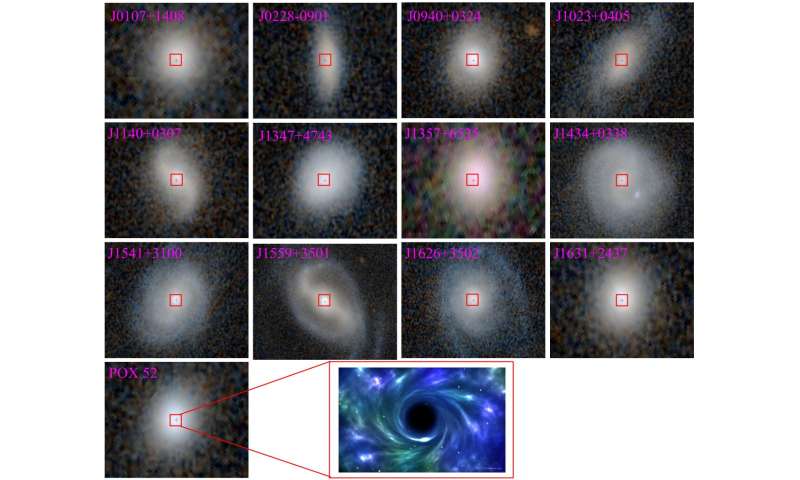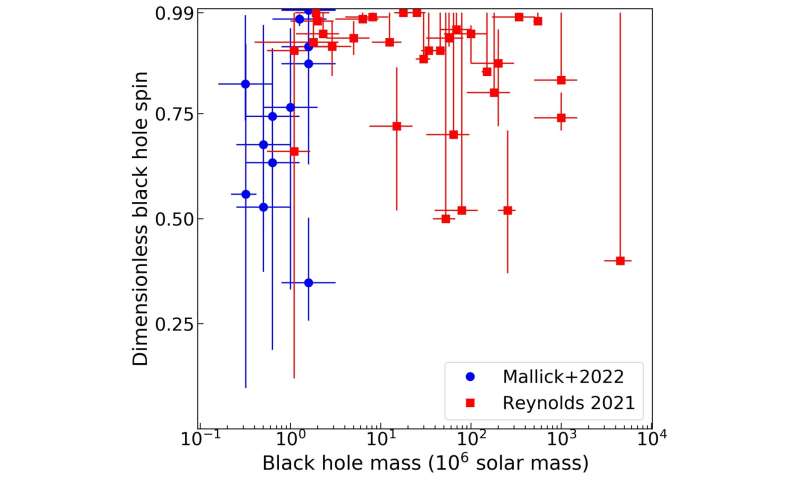Astronomers survey the least massive black holes at the center of galaxies in the local universe

Our research work has, for the first time, revealed the nature of the least massive supermassive black holes at the centers of nearby galaxies. We used high-quality X-ray data from the European Space Agency's XMM-Newton observatory to closely study the temporal and spectral behaviors of a sample of active galactic nuclei hosting the smallest supermassive black holes at the center.
An active galactic nucleus (AGN) is the most luminous, compact region at the center of a galaxy, and the galaxy hosting an AGN is known as the active galaxy. Our universe is the home of countless mysterious objects. Supermassive black holes, sitting at the center of active galaxies, are examples of such exotic objects, and they can have masses of about 105 up to 1010 times that of the sun. However, most of our knowledge on the physical processes occurring in the AGN central engine is limited to active galaxies hosting supermassive black holes of mass greater than 106 times that of the sun, and we know very little about the low-mass end of AGNs, where the mass of the central supermassive black hole is 105 to 106 times the solar mass. The least massive AGNs can provide new insight into how supermassive black holes grow at the center of galaxies and are crucial for constraining the cosmological black hole growth models.
As AGNs are best-studied in the X-ray waveband, we started hunting for the least-massive AGNs in the X-ray archives, which revealed 29 objects in the field of view of XMM-Newton. Some of these objects do not even have pointed X-ray observations. No scientific study before our investigations has unveiled detailed physical properties of the least massive AGN sample, even with the other X-ray telescopes around the world, such as Chandra, Suzaku, NuSTAR, etc. This can be explained either by the limited sensitivity of the current X-ray telescopes or the scarcity of small supermassive black holes in our local universe.
We performed an in-depth investigation of the selected 13 sources having high signal-to-noise XMM-Newton data. Figure 1 shows the optical images of the selected 13 galaxies as observed by the Panoramic Survey Telescope and Rapid Response System (Pan-STARRS ). We first measured the time delays between soft and hard X-ray photons and map the geometry of the X-ray-emitting region, known as the corona, located close to the central black hole. Our findings suggest that the size of the X-ray emitting corona does not necessarily depend on the black hole's mass. Instead, coronal size depends on the black hole's spin—another fundamental parameter that characterizes a black hole. We infer that the more compact corona can be found only around the more rapidly rotating black holes.

The variation of X-ray photon counts as a function of energy revealed an excess emission in the lower-energy X-ray band below 1.5 kilo electronvolts for each low-mass AGN, similar to what we usually observe in high-mass AGNs. We recently developed a new model to explain that excess emission, which revealed an incredibly dense (1018 per cubic centimeters) illuminated atmosphere surrounding the black hole. We expect the least-massive AGNs to have a denser environment than their higher-mass counterparts, according to a theory predicted nearly 50 years ago. We noticed a drop in black hole spin at low-mass regimes (see Figure 2), which tells us that the collision or merger of intermediate-mass black hole pairs could form the small supermassive black holes. Nonetheless, we will have to wait for ESA's future gravitational wave detector LISA to confirm this scenario.
This story is part of Science X Dialog, where researchers can report findings from their published research articles. Visit this page for information about ScienceX Dialog and how to participate.
More information:
L. Mallick et al. High-density disc reflection spectroscopy of low-mass active galactic nuclei, MNRAS (2022). DOI: doi.org/10.1093/mnras/stac990
Labani Mallick is a postdoctoral research associate at the California Institute of Technology (Caltech). Her research focuses on black hole accretion in extreme gravity regimes as well as cosmic surveys. She performs spectral-timing analysis of accreting supermassive and intermediate-mass black holes using data from various space-based telescopes and studies matter spiraling in the inner accretion flow.